Researchers are hunting for the “climate gene” that can save food plants
If plants are to adapt to a harsher climate, they must have genes that tolerate stress. Read more here.
If plants are to adapt to a harsher climate, they must have genes that tolerate stress. Read more here.
An international team of scientists, including some from India, has found a way to breed wheat varieties that are of better quality and have a higher yield while also resisting diseases and the adverse effects of climate change. Read more here.
In July 2019 ICIMOD, along with its partners and the International Maize and Wheat Improvement Centre in Mexico, launched a web-based Regional Drought Monitoring and Outlook System for South Asia – an integrated information platform linking weather and climate data with agriculture practices in South Asia. The system provides multiple indices for droughts and seasonal weather outlooks, besides maps and baseline. Read more here.
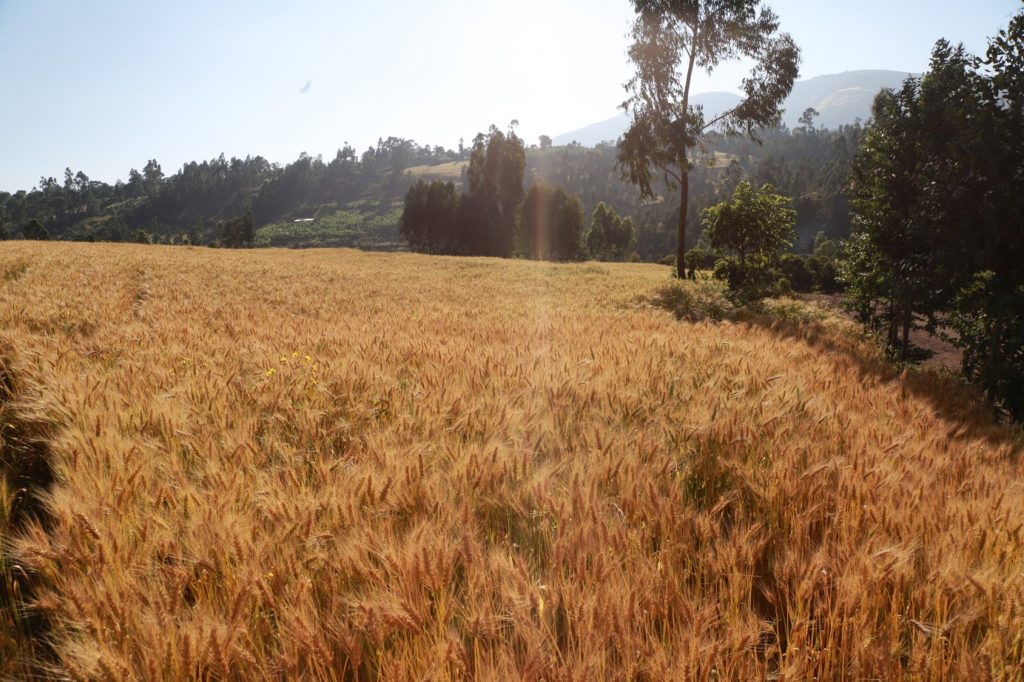
Using the full wheat genome map published in 2018, combined with data from field testing of wheat breeding lines in multiple countries, an international team of scientists has identified significant new chromosomal regions for wheat yield and disease resistance and created a freely-available collection of genetic information and markers for more than 40,000 wheat lines.
Reported today in Nature Genetics, the results will speed up global efforts to breed more productive and climate-resilient varieties of bread wheat, a critical crop for world food security that is under threat from rising temperatures, rapidly-evolving fungal pathogens, and more frequent droughts, according to Philomin Juliana, wheat scientist at the International Maize and Wheat Improvement Center (CIMMYT) and first author of the new study.
“This work directly connects the wheat genome reference map with wheat lines and extensive field data from CIMMYT’s global wheat breeding network,” said Juliana. “That network in turn links to over 200 breeding programs and research centers worldwide and contributes to yield and other key traits in varieties sown on nearly half the world’s wheat lands.”
The staple food for more than 2.5 billion people, wheat provides 20% of human dietary calories and protein worldwide and is critical for the nutrition and food security of hundreds of millions of poor persons in regions such as North Africa and South Asia.
“Farmers and societies today face new challenges to feed rising and rapidly-urbanizing populations, and wheat epitomizes the issues,” said Ravi Singh, CIMMYT wheat breeder and corresponding author of the study. “Higher temperatures are holding back yields in major wheat-growing areas, extreme weather events are common, crop diseases are spreading and becoming more virulent, and soil and water are being depleted.”
Juliana said the study results help pave the way to apply genomic selection, an approach that has transformed dairy cow husbandry, for more efficient wheat breeding.
“Molecular markers are getting cheaper to use; meanwhile, it’s very costly to do field testing and selection involving many thousands of wheat plants over successive generations,” Juliana said. “Genome-wide marker-based selection can help breeders to precisely identify good lines in early breeding generations and to test plantlets in greenhouses, thereby complementing and streamlining field testing.”
The new study found that genomic selection could be particularly effective in breeding for wheat end-use quality and for resistance to stem rust disease, whose causal pathogen has been evolving and spreading in the form of highly-virulent new races.
The new study also documents the effectiveness of the global public breeding efforts by CIMMYT and partners, showing that improved wheat varieties from this work have accumulated multiple gene variants that favor higher yields, according to Hans-Joachim Braun, director of CIMMYT’s global wheat program.
“This international collaboration, which is the world’s largest publicly-funded wheat breeding program, benefits farmers worldwide and offers high-quality wheat lines that are released directly to farmers in countries, such as Afghanistan, that are unable to run a full-fledged wheat breeding program,” Braun explained.
The study results are expected to support future gene discovery, molecular breeding, and gene editing in wheat, Braun said.
Together with more resource-efficient cropping systems, high-yielding and climate-resilient wheat varieties will constitute a key component of the sustainable intensification of food production described in Strategy 3 of the recent EAT-Lancet Commission recommendations to transform the global food system. Large-scale genomics will play a key role in developing these varieties and staying ahead of climate- and disease-related threats to food security.
Funders of this work include USAID’s Feed the Future Innovation Lab for Applied Wheat Genomics. Contributing to the research described are research teams engaged in wheat improvement at CIMMYT, and the lab of Jesse Poland, Associate Professor at Kansas State University and Director of the USAID Applied Wheat Genomics Innovation Lab.
For more information, or to arrange interviews with the researchers, please contact:
Marcia MacNeil, Wheat Communications Officer, CIMMYT
M.MacNeil@cgiar.org, +52 (55) 5804 2004, ext. 2070
Approaching the homestead of Joseph Maravire and his wife, Reason, on a warm late August afternoon in Bvukururu, Zaka district, Zimbabwe, heaps of dry straw in their farmyard are prominent. ‘’This is for mulching for the forthcoming cropping season,’’ explains Reason. Maize stalk residues from last harvest are also stored to feed their livestock and to mix into the manure or for bedding the herd of cattle. These practices have become the norm for the Maravire family as they prepare for the next maize planting season in Zaka, one of the hottest areas of southern Zimbabwe.
“We never knew of mulching until we interacted with CIMMYT scientists in 2009. Now I cannot imagine working in my field without applying mulch,” says Reason. As one of five families selected in their village to participate in the scaling out of climate-smart agricultural technologies since 2009, the Maravire family demonstrates the evident transformative power of climate-smart agriculture.
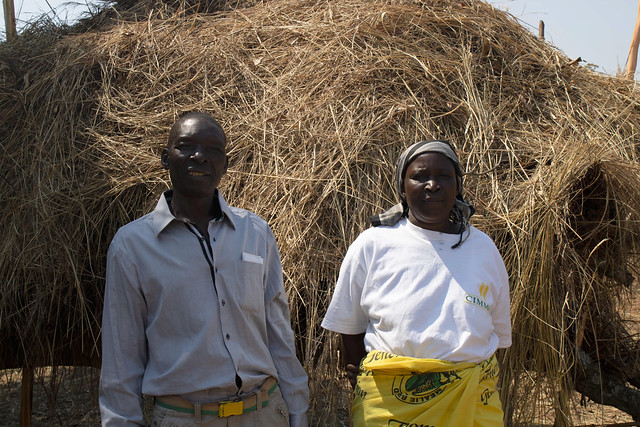
Climate-smart agriculture involves farming practices that improve farm productivity and profitability, help farmers adapt to the negative effects of climate change and mitigate climate change effects, e.g. by soil carbon sequestration or reductions in greenhouse gas emissions. Climate-smart practices, such as the locally practiced conservation agriculture, aim at conserving soil moisture, retaining crop residues for soil fertility, disturbing the soil as minimally as possible and diversifying through rotation or intercropping.
As CIMMYT research shows, these practices can boost production and make farmers more food secure. This is good news for Zimbabwean farmers such as the Maravires. During an episode of El Niño in the 2015-16 and 2018-19 cropping seasons, large parts of southern Africa experienced prolonged dry spells, erratic rainfall and high temperatures initially with floods towards the end of the cropping season. A recent humanitarian appeal indicated that at least 2.9 million people in Zimbabwe were severely food insecure due to poor or no harvests that year.
Under the “Out-scaling climate-smart technologies to smallholder farmers in Malawi, Zambia & Zimbabwe’’ project — funded by the German development agency GIZ and the Centre for Coordination of Agricultural Research and Development for Southern Africa (CCARDESA), and implemented under the leadership of the Zambian Agriculture Research Institute (ZARI) with technical oversight by CIMMYT and other collaborating partners from Malawi and Zimbabwe — farmers from 19 rural communities in the three target countries received training and guidance on climate-smart agriculture practices and technologies, such as mulching, rotation and the use of direct seeders and ripper tines to practice no tillage.
Mastering climate-smart techniques, season by season
On their 0.4-hectare plot dedicated to the project activities, Joseph and Reason practiced four different planting techniques: direct seeding (sowing directly into crop residue), ripline seeding (sowing in lines created by animal draft-powered rippers), basin planting (sowing manually into planting basins created by hand hoes), and the traditional ox drawn plowing and seeding. They then planted one traditional and three drought-tolerant maize varieties.
“It soon became clear to us that using a direct seeder or ripper tine, combined with mulching, was the best option, as these sections of the field retained more moisture and produced more maize than the conventional system,” explained Joseph Maravire. Beginning in 2013, the family also started rotating maize and cowpeas and observed a significant increase in their yields. They decided to apply climate-smart agriculture practices on the rest of their 2.5-hectare farm.
“We learned that cowpeas leave nitrogen in the soil and by the time of harvesting, the leaves from the cowpeas also fall to the ground as residue and add to the mulch for the soil. The shade of cowpea also reduces weed pressure and manual weeding,” said Maravire.
Yields and food security
With these practices, the family has harvested remarkably, even during the dry seasons. In 2015-16, the worst El Niño on record, they harvested 2 tons of maize, despite the severe drought, while other households barely got anything from their fields. In good years, like the last cropping season, the family harvests 3.5 to 4 tons of maize from their entire field, three times more than their annual family food needs of approximately 1.3 tons. The additional cowpea yields of both grain and leaves provide protein-rich complementary food, which improves the family’s nutrition. To share some of these benefits with their community, the Maravire family donates up to 10% of their produce to poor elderly households in their village.
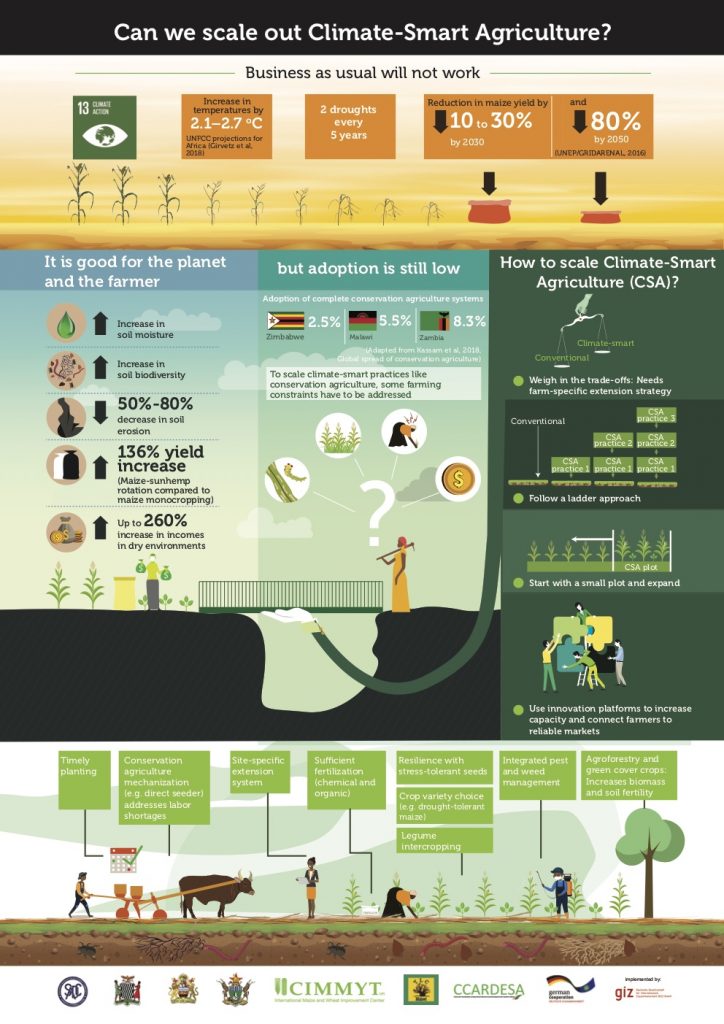 Overcoming challenges and building resilience
Overcoming challenges and building resilience
However, the new farming practices did not come without challenges.
“In the early days of the project, the ripper tine was not simple to use because we could not get the right depth to put manure and the maize seeds,” said Joseph Maravire.
They found a solution by making rip lines around October or November, applying manure at the onset of the rains, ripping again and placing the seed to mix with the manure.
Fall armyworm was another devastating challenge for their plot, as was the case around Zimbabwe. Like other farmers in Zimbabwe, the Maravires had access to pesticides, but the caterpillar showed some resistance to one type of pesticide. Maravire expressed interest in learning biological control options to reduce the pest’s spread.
Scaling climate smart technologies beyond the Maravire homestead
After several years of consistently good harvests with climate-smart agriculture options, the Maravire family has become a model within their community. Working closely with their agricultural extension officer, they formed a CSA farmer support group of 20 families. Joseph Maravire provides services for direct seeding and ripping to the CSA group and ensures that all of their land is prepared using no-tillage planting techniques. The couple regularly demonstrates climate-smart practices to peers during field days, where an average of 300 villagers attend. They also share their knowledge about green manure cover crops — crops such as lablab, jackbean, sunhemp, and velvet bean which, retained on the soil surface, serve as organic fertilizer — a practice they learned from project activities.
For Reason and Joseph Maravire, the rewards for adopting climate-smart agriculture benefit the family beyond food security. The income earned from maize grain sales and cowpea marketing has helped them acquire assets and rebuild one of their homes that was destroyed by Cyclone Idai in March 2019.
Joseph is confident that his family will always produce well on the replenished soil and the technologies they have learned through the project will continue to define their farming practices.
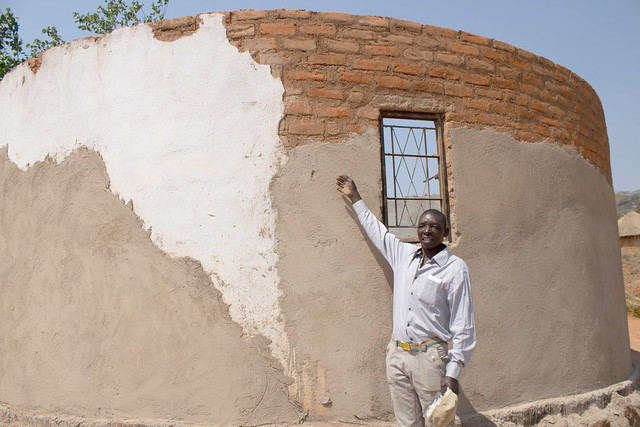
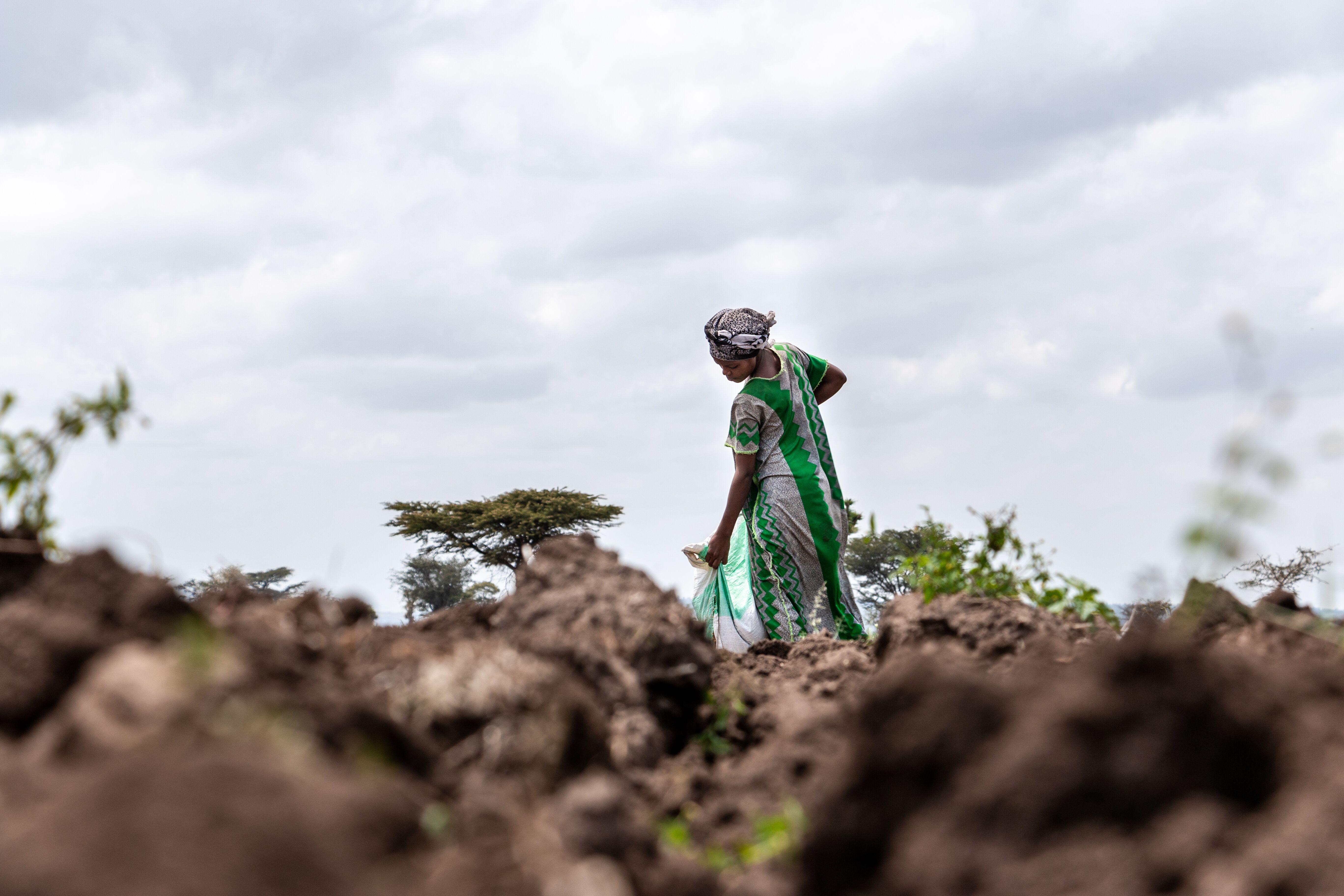
New research shows that smallholder farmers in Ethiopia used various coping mechanisms apart from fungicides in response to the recent wheat rust epidemics in the country. Scientists from the International Maize and Wheat Improvement Center (CIMMYT) and the Ethiopian Institute of Agricultural Research (EIAR) call for continuous support to research and extension programs to develop and disseminate improved wheat varieties with resistant traits to old and newly emerging rust races.
Rising wheat yields cannot catch up rising demand
Wheat is the fourth largest food crop in Ethiopia cultivated by smallholders, after teff, maize and sorghum. Ethiopia is the largest wheat producer in sub-Saharan Africa and average farm yields have more than doubled in the past two decades, reaching 2.74 tons per hectare on average in 2017/18. Farmers who use improved wheat varieties together with recommended agronomic practices recorded 4 to 6 tons per hectare in high-potential wheat growing areas such as the Arsi and Bale zones. Yet the country remains a net importer because demand for wheat is rapidly rising.
The Ethiopian government has targeted wheat self-sufficiency by 2023 and the country has huge production potential due to its various favorable agroecologies for wheat production.
However, one major challenge to boosting wheat production and yields is farmers’ vulnerability to rapidly evolving wheat diseases like wheat rusts.
The Ethiopian highlands have long been known as hot spots for stem and yellow wheat rusts caused by the fungus Puccinia spp., which can spread easily under favorable climatic conditions. Such threats may grow with a changing climate.
Recurrent outbreaks of the two rusts destroyed significant areas of popular wheat varieties. In 2010, a yellow rust epidemic severely affected the popular Kubsa variety. In 2013/14, farmers in the Arsi and Bale zones saw a new stem rust race destroy entire fields of the bread wheat Digalu variety.
In response to the 2010 yellow rust outbreak, the government and non-government organizations, seed enterprises and other development supporters increased the supply of yellow rust resistant varieties like Kakaba and Danda’a.
Fungicide is not the only solution for wheat smallholder farmers
Two household panel surveys during the 2009/10 main cropping season, before the yellow rust epidemic, and during the 2013/14 cropping season analyzed farmers’ exposure to wheat rusts and their coping mechanisms. From the survey, 44% of the wheat farming families reported yellow rust in their fields during the 2010/11 epidemic.
Household data analysis looked at the correlation between household characteristics, their coping strategies against wheat rust and farm yields. The study revealed there was a 29 to 41% yield advantage by increasing wheat area of the new, resistant varieties even under normal seasons with minimum rust occurrence in the field. Continuous varietal development in responding to emerging new rust races and supporting the deployment of newly released rust resistant varieties could help smallholders cope against the disease and maintain improved yields in the rust prone environments of Ethiopia.
The case study showed that apart from using fungicides, increasing wheat area under yellow rust resistant varieties, increasing diversity of wheat varieties grown, or a combination of these strategies were the main coping mechanisms farmers had taken to prevent new rust damages. Large-scale replacement of highly susceptible varieties by new rust resistant varieties was observed after the 2010/11 epidemic.
The most significant wheat grain yield increases were observed for farmers who increased both area under resistant varieties and number of wheat varieties grown per season.
The additional yield gain thanks to the large-scale adoption of yellow rust resistant varieties observed after the 2010/11 epidemic makes a very strong case to further strengthen wheat research and extension investments, so that more Ethiopian farmers have access to improved wheat varieties resistant to old and newly emerging rust races.
Read the full study on PLOS ONE:
https://doi.org/10.1371/journal.pone.0219327
The International Maize and Wheat Improvement Center (CIMMYT) organized its first ever Maize Product Profile-based Breeding and Varietal Turnover workshop for eastern Africa in Nairobi, on August 29 and 30, 2019. The workshop, funded by USAID, was attended by maize breeders from national research institutes in Kenya, Uganda, Tanzania, Rwanda, Ethiopia and South Sudan, and by several partner seed companies including Seedco, Kenya Seeds, Western Seeds, Naseco and Meru Agro.
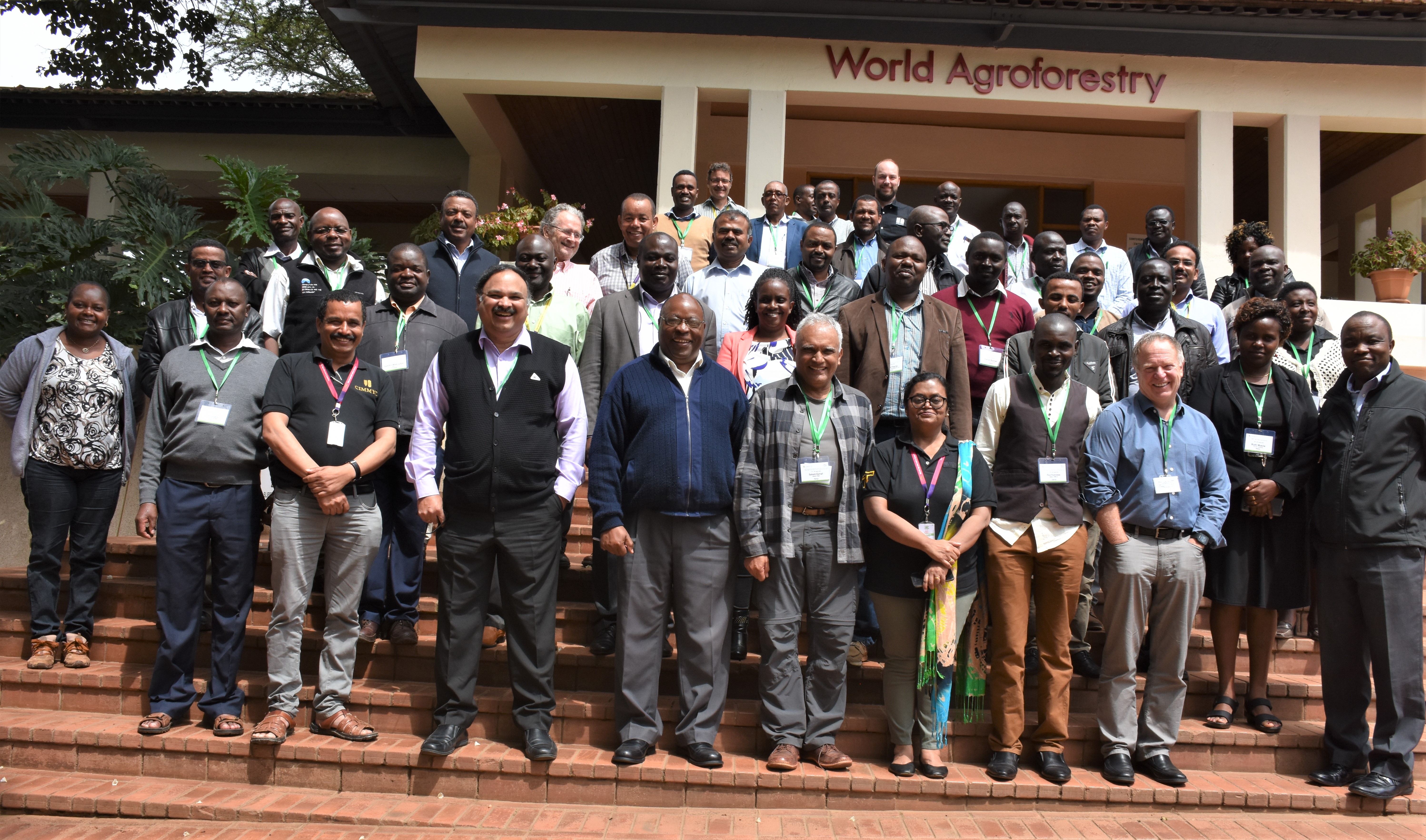
A product profile is defined as a list of “must-have” maize characteristics or traits that are the unique selling points for the target beneficiaries who are looking for these qualities. The breeders also consider additional traits in their breeding strategy, “value-added” or desirable traits that could be future unique selling points.
“A product profile is not a secret sauce” nor a checkbox to tick, explained Georges Kotch, a renowned expert in the seed industry and lead for Module 1 of the Excellence in Breeding (EiB) platform on product profiling. A product profile is a blueprint to help maize breeding programs ensure their new varieties released respond to a true need with a clear comparative advantage for seed companies and ultimately for maize farmers. This demand-driven process “starts with the end in mind” by understanding what the customers want. The end goal is to replace leading old varieties on the market with better ones that will improve farmers’ livelihoods, for example, with greater climate resilience and productivity.
Steering the breeding program through “healthy tensions”
Breeders may have had the tendency to focus on optimum yield for a certain agroecology, yet their priority traits may not reflect exactly the market or what farmers want. In addition to good yield, drought or disease resistance, grain color, taste, nutritional value, and appearance of plants and cobs are important in farmers’ choice of seed. Socio-economic research tools like participatory varietal selection (PVS) or willingness-to-pay experiments help us weigh the importance of each trait to trigger adoption.
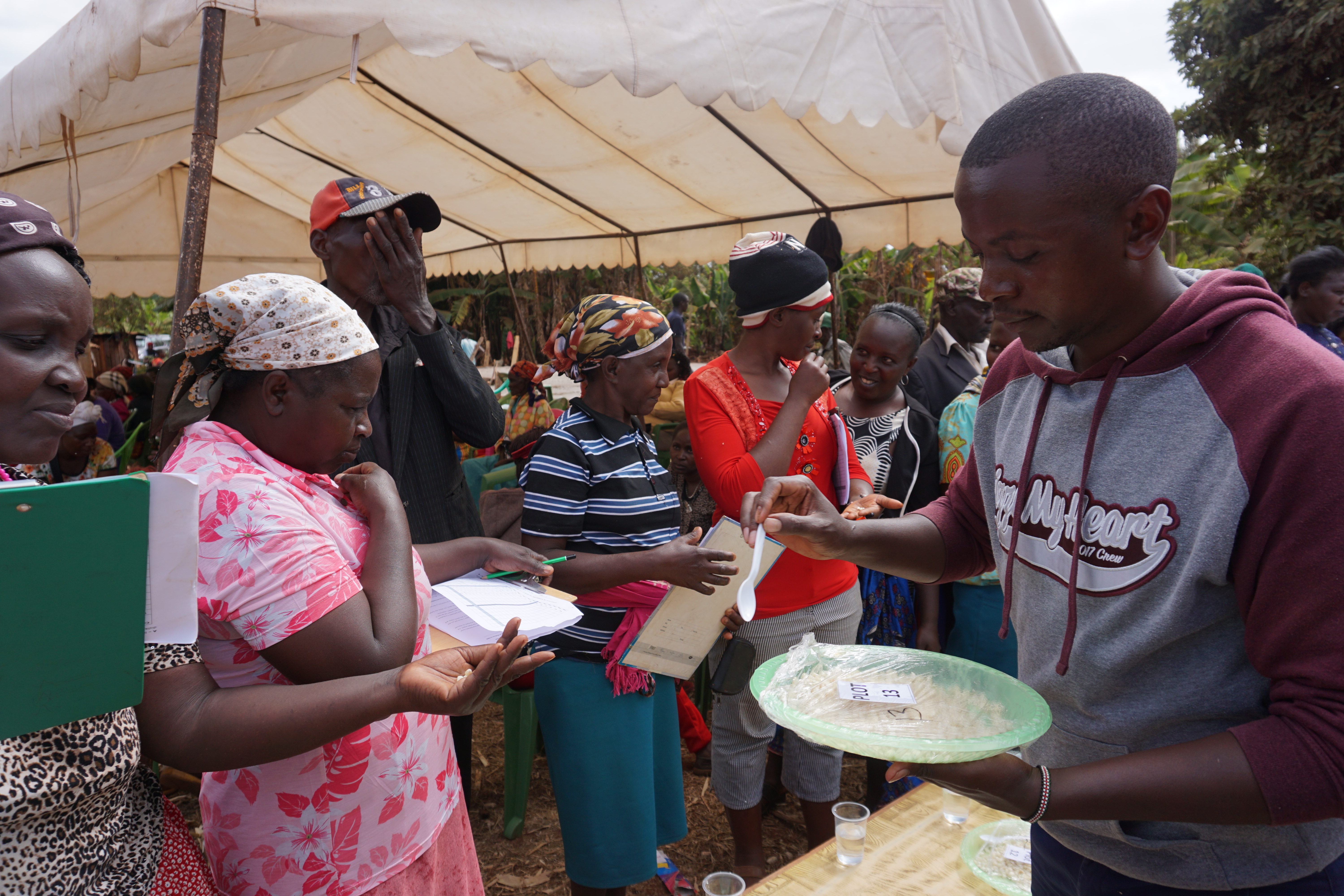
There may be tensions between farmers’ needs, what suits seed companies like the seed reproducibility ratio, and what is possible and cost-effective from a breeder’s perspective. CIMMYT does not only look through the lens of economic return. The social impact new varieties could have is also considered, for example developing provitamin A or quality protein maize (QPM) as a solution to combat malnutrition even if there is not a major demand from private seed companies in Africa for nutritious maize.
Qualities valued by some actors may be overlooked by others. For example, some maize varieties have leafy ears with deceptively small cobs, which may protect the grain against pests but could be rejected by farmers.
It is important to have a wide array of expertise from breeding, market research and socio-economic analysis so that the different trait choices are weighed according to different lenses and a clear strategy for varietal turnover is defined.
High performing hybrids may not be enough for large-scale adoption
In southern Africa, climate experts warn that farmers could face drought every three years. CIMMYT has rightly prioritized drought tolerance (DT) over the last decade under the Stress Tolerant Maize for Africa initiative. Recently developed DT maize hybrids often outperform the popular varieties on the market, yet the varietal turnover has been slow in some regions. Farmers’ perceptions of what is a good maize may influence the success or rejection of a new variety. The risk for farmers and seed companies to try out a new variety is an important factor in adoption as well.
An appropriate seed marketing strategy is key, often seen only as the responsibility of private seed companies, but should be considered by public research as well.
CIMMYT has been selecting maize that can withstand drought during the critical phase just before and during the flowering stage, when the silks of the future cobs form. Even if rains stop at this stage, farmers growing DT maize will harvest some decent grain. If a long dry spell occurs just after planting, the crop will fail regardless of drought-tolerant breeding efforts. Farmers may then reject DT maize after such failure if the messaging is not clear.
Product profiling is a collaborative process, not an imposing one
Redefining the breeding strategy through product profiling is not set in stone. Kotch recommends annual review as a vehicle for constant improvement. B.M. Prasanna, director of CIMMYT’s Global Maize Program and the CGIAR Research Program on Maize (MAIZE) explained that the product profiles could vary among various partners, as each partner looks at their own comparative advantage to reach success.
It is important to have everyone from the maize seed value chain on board to succeed. Regina Tende, maize breeder and entomologist at the Kenya Agricultural & Livestock Research Organization (KALRO), warned that regulatory bodies who review and authorize new varieties to reach the market must be integrated in the discussion “as their interest, primarily yield, may not be the final requirement for the target market.”
Seed systems specialists are also crucial to operationalize a successful breeding and delivery strategy, to address the different scaling bottlenecks and identify “the market changer.”
According to Kotch, CGIAR and national research organizations should avoid developing products too similar to the popular varieties on the market. Adoption occurs when something very different, for example new resistance to the devastating maize lethal necrosis, gives an innovation edge to seed companies. In Ethiopia, the replacement of an old popular variety BH660 by climate resilient BH661 was successful for various reasons including superior hybrid seed production with grey leaf spot resistance built in the seed parent population.
This demand-driven, multi-lens approach of product profiling including breeding, gender, socio-economic and policy dimensions will help to ensure that new varieties are more likely to be picked by farmers and partner seed companies, and increase the impact of CIMMYT’s Global Maize Program.
Around 10 years ago, CIMMYT began work on developing wheat with higher zinc and iron, under an initiative called HarvestPlus. CIMMYT has released eleven varieties of zinc wheat in India, which are also high-yielding and disease-resistant. Read more here.
Anne Wambui has been growing maize in her farm located in the upper eastern Kenyan county of Embu for three decades to cater for domestic consumption and sale in the nearby market.
During this period, she has relied on buying varieties from seed stockists that are either recommended by the agricultural extension officials or not necessarily varieties that she prefers to plant.
However, scientists at the International Maize and Wheat Improvement Center (CIMMYT) emphasized that farmers should be availed varieties that meet their varied needs.
Read more here.
In the early 20th century, Aaron Aaronsohn, a prominent agronomist best known for identifying the progenitor of wheat, began looking for durum wheat landraces in Israel. He traveled to villages across the country, carefully collecting and recording details of the local varieties used in each area.
This task was not without purpose. Aaronsohn recognized that as increasing numbers of settlers like himself came to the territory, the varietal change from the introduction of new and competitive wheat varieties and the rapid intensification of agriculture would soon cause all the traditional structures he had identified to disappear.

Aaronsohn was one of the first to begin collecting germplasm in the region, but others saw the importance of collecting before large-scale change occurred. For example, Russian botanist Nikolai Vavilov gathered samples from Israel on one of his expeditions through the Middle East. By the end of the century, a number of collections had been established, but overall efforts at conservation were fragmented.
“That’s why we say the collection was on the verge of extinction,” explains Roi Ben-David, a researcher at the Volcani Center, Israel’s Agricultural Research Institute (ARO). “There were single accessions in genebanks around the world but no one really gave them special treatment or saw their value. Many were in private collections; others were simply lost.”
When Ben-David and his colleagues began looking for landraces six years ago, even the collection housed at the Israeli Genebank (IGB) was disappointing, with many samples stored in unmarked boxes in sub-optimal conditions. “When we came in nobody was really trying to study what we had and put it together to represent the area’s wheat landscape as it was 100 years ago.”
Long-term efforts to restore and conserve a collection of Israeli and Palestinian wheat landraces (IPLR) have led to the restoration of 930 lines so far, but there are many varieties that cannot be recovered. Therefore, it came as a great surprise to Ben-David when he arrived at the International Maize and Wheat Improvement Center (CIMMYT) headquarters in Mexico and stumbled upon one of the collections presumed lost. “I think it was actually my first week at CIMMYT when I spotted a demonstration plot growing one of the lost varieties — a subset of the Ephrat-Blum collection — and I couldn’t believe it.”
He had heard about this collection from the late Abraham Blum, but had never been able to locate it. “Someone might have moved the seeds, or maybe the box was not well labelled and thrown out. We don’t know, but needless to say it was a very good surprise to rediscover 64 of our missing lines.”
What prompted you and your colleagues to start looking for landraces in Israel?
We began because we recognized local landraces are good genetic resources but unfortunately, we couldn’t find any. It wasn’t so much that they didn’t exist, but the accessions were scattered across the world, mostly in private collections in countries like the USA or Australia. The Israeli Genebank, which sits only two floors above my office, had a few buckets of germplasm but nobody really knew what was inside.
The Middle East and the Fertile Crescent are centers of diversity, not only for wheat but for all crops that were part of the Neolithic revolution 10,000 years ago. They started here – the exact point of origin was probably in what is now southeast Turkey – so we have had thousands of years of evolution in which those landraces dominated the agricultural landscape and adapted to different environments.
Why do you think so much of the collection was lost?
The lines from Israel were lost because their conservation simply wasn’t prioritized. Losses happen everywhere but what was missing in this case was the urgency and understanding of just how important these collections are. Luckily, the current manager of the IGB, who is a fundamental partner in building the IPLR, understood the need to prioritize this and allocated a budget to conserve it as one collection.
What is the value of conserving landraces and why should it be prioritized?
Landraces are an extremely important genetic resource. Wild relatives are the biggest treasure, but breeders are usually reluctant to use them because they are so very different from modern varieties. So landraces form the link between these two, having already been domesticated and developed within farming systems while remaining genetically distinct from the modern. In wheat, they’re quite easy to spot because of how tall they are compared to the semi-dwarf varieties that replaced them in the 20th century.
There are two main reasons why we need to prioritize conservation. First, we believe that the evolution under domestication in this region is important to the community as a whole. Second, it is now a critical time, as we’re getting further from the time in which those traditional lines were in use. The last collection was carried out in the 1980s, when people were still able to collect authentic landraces from farmers but this is just not possible any more. We travelled all over the country but the samples we collected were not authentic – most were modern varieties that farmers thought were traditional. Not everybody knows exactly what they’re growing.
The time factor is critical. If we were to wake up 50 years from now and decide that it’s important to start looking for landraces, I don’t know how much we could actually save.

Are there any farmers still growing landraces in Israel?
When we started looking for farmers who are still growing landraces we only found one farm. It is quite small – only about ten acres shared between two brothers. They grow a variety which is typically used to make a traditional food called kube, a kind of meat ball covered in flour and then then either fried or boiled. If you boil it using regular flour it falls apart, so people prefer to use a landrace variety, which is what the brothers grow and are able to sell for up to six times as much as regular durum wheat in the market. However, they’re not really interested in getting rich; they’re just trying to keep their traditions alive.
How are you and your colleagues working to conserve the existing collection?
There are two approaches. We want to develop is ex-situ conservations to preserve the diversity. As landraces are not always easy to conserve in a genebank, we also want to support in-situ conservation in the field, like traditional farmers have done. Together with the IGB we’ve distributed seed to botanical gardens and other actors in the hope that at least some of them will propagate it in their fields.
Having established the collection, we’re also trying to utilize it for research and breeding as much as possible. So far we’ve characterized it genetically, tested for drought tolerance and other agronomic traits and we’re in talks to start testing the quality profile of the lines.
Did you continue working on this while you were based at CIMMYT?
Yes, this was an additional project I brought with me during my sabbatical. The main success was working with Carolina Sansaloni and the team at the Genetic Resources program to carry out the genotyping. If it were left to my own resources, I don’t think we could have done it as the collection contains 930 plant genotypes and we only had the budget to do 90.
Luckily, CIMMYT also has an interest in the material so we could collaborate. We brought the material, CIMMYT provided technical support and we were able to genotype it all, which is a huge boost for the project. We had already been measuring phenotypes in Israel, but now that we have all the genetic data as well we can study the collection more deeply and start looking for specific genes of interest.
What will happen to the lines you discovered at CIMMYT?
They’ve been sent back to Israel to be reintegrated into the collection. I want to continue collaborating with people in CIMMYT’s Genetic Resources program and genebank to do some comparative genomics and assess how much diversity we have in the IPLR collection compared with what CIMMYT has. Is there any additional genetic diversity? How does it compare to other landraces collections? That is what we want to find out next.
Roi Ben-David is based at Israel’s Agricultural Research Organization (ARO). He works in the Plant Institute, where his lab focuses on breeding winter cereals such as wheat. He has recently completed a one-year sabbatical placement at the International Maize and Wheat Improvement Center (CIMMYT).
CIMMYT’s germplasm banks contain the largest and most diverse collections of maize and wheat in the world. Improved and conserved seed is available to any research institution worldwide.
How to track adoption and assess the impact of maize and wheat varieties? Some of the methods used until now, like farmers’ recall surveys, have various limitations. In addition to relying exclusively on people’s memory and subjectivity, they are difficult to replicate and prone to errors.
DNA fingerprinting, on the other hand, allows objective evaluation and is considered the “gold standard” method for adoption and impact assessments.
It consists of a chemical test that shows the genetic makeup of living things, by separating strands of DNA and revealing the unique parts of their genome. The results show up as a pattern of stripes that can be matched against other samples.
This technique is extremely helpful in tracking crop varieties and monitoring their adoption. It can be used to assess the impact of research-for-development investments, guide breeding and seed system strategies, implement the intellectual property rights of breeders, assess the use of crop genetic resources, and informing policy.
On June 25, 2019, the International Maize and Wheat Improvement Center (CIMMYT) held a half-day workshop in Addis Ababa to discuss the use and application of DNA fingerprinting in Ethiopia for the tracking of crop varieties.
High-level government officials and major players in the agricultural sector were interested in learning more about the policy implications of this tool and how to mainstream its use.
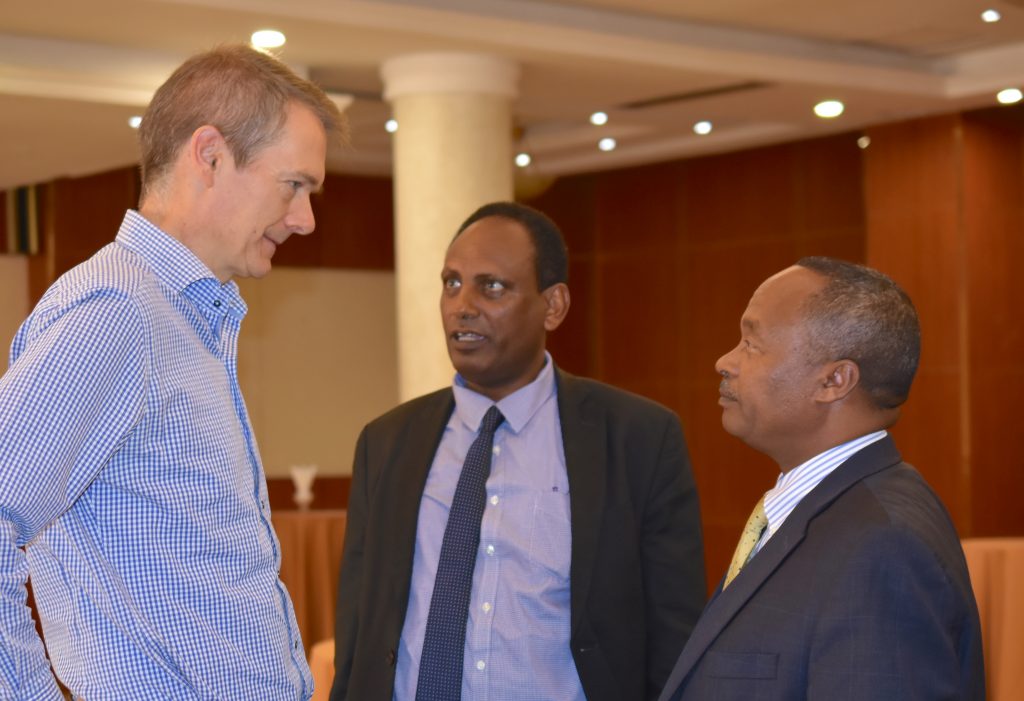
Introducing DNA fingerprinting in Ethiopia
The main DNA fingerprinting project in Ethiopia has been in operation since January 2016, focusing on the country’s two major staple crops: wheat and maize. The project covers the Amhara, Oromia, SNNPR, and Tigray regions, which together account for 92% and 79% of the national wheat and maize production.
The Bill & Melinda Gates Foundation has funded the project, which was jointly implemented by CIMMYT, the Ethiopian Institute of Agricultural Research (EIAR), Ethiopia’s Central Statistical Agency (CSA) and Diversity Arrays Technology (DArT).
The main objective of the project was to generate a knowledge base for the practical use of DNA fingerprinting, to mainstream the use of this technology, and to offer policy options and recommendations.
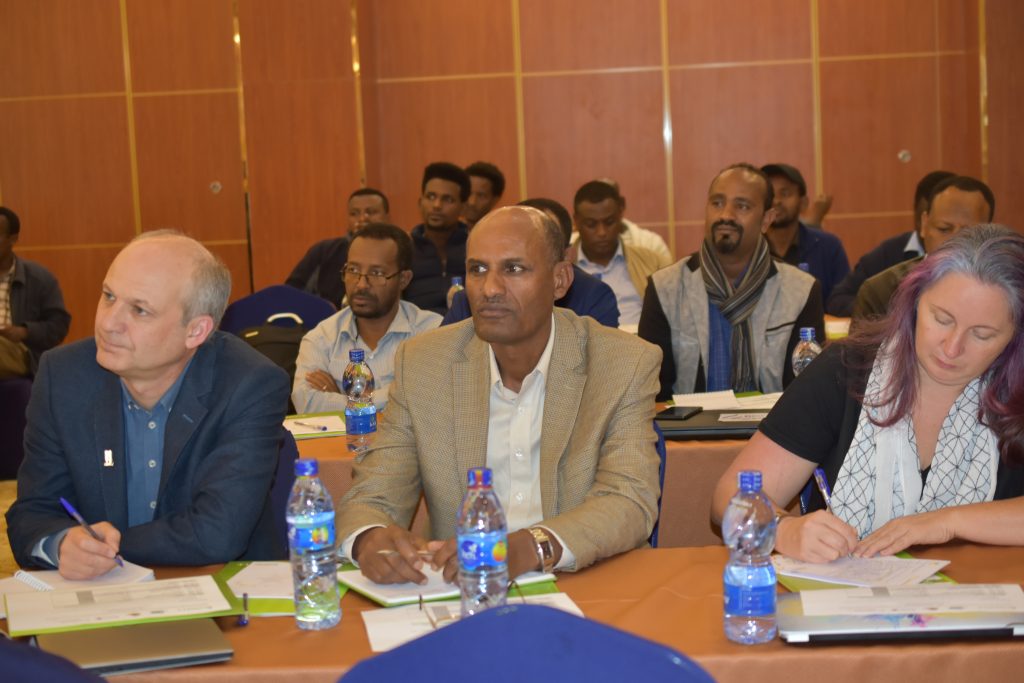
Better monitoring for wheat self-sufficiency
At the workshop, researchers presented two policy briefs specific to Ethiopia: one focusing on policy implications of DNA fingerprinting for tracking bread wheat varieties and another one on how to revitalize the durum wheat sub-sector.
Speaking at the workshop, Eyasu Abraha, Minister of Agriculture and Natural Resources, noted that the government planned to achieve wheat grain self-sufficiency in the next few years by increasing wheat productivity in the highlands and expanding wheat production to the lowlands through irrigation. In this regard, improved crop variety development and dissemination is one of the key elements to increase agricultural productivity and improve the livelihood of millions of smallholder farmers.
According to Abraha, more than 130 wheat varieties have been released or registered in Ethiopia since the late 1960s, in collaboration with international research organizations. Public and private seed enterprises have multiplied and distributed these varieties to reach smallholder farmers.
Even though adoption studies have been conducted, there is still a strong need for more accurate and wider studies. In addition to tracking adoption and demand, using DNA fingerprinting could help understand the distribution of varieties across space and time.
Members of the International Maize Improvement Consortium Africa (IMIC – Africa) and other maize and wheat research partners discovered the latest innovations in seed and agronomy at Embu and Naivasha research stations in Kenya on August 27 and 28, 2019. The International Maize and Wheat Improvement Center (CIMMYT) and the Kenya Agriculture & Livestock Research Organization (KALRO) held their annual partner field days to present sustainable solutions for farmers to cope with poor soils, a changing climate and emerging diseases and pests, such as wheat rust, maize lethal necrosis or fall armyworm.
Versatile seeds and conservation agriculture offer farmers yield stability
“Maize is food in Kenya. Wheat is also gaining importance for our countries in eastern Africa,” KALRO Embu Center Director, Patrick Gicheru, remarked. “We have been collaborating for many years with CIMMYT on maize and wheat research to develop and disseminate improved technologies that help our farmers cope against many challenges,” he said.
Farmers in Embu, like in most parts of Kenya, faced a month delay in the onset of rains last planting season. Such climate variability presents a challenge for farmers in choosing the right maize varieties. During the field days, CIMMYT and KALRO maize breeders presented high-yielding maize germplasm adapted to diverse agro-ecological conditions, ranging from early to late maturity and from lowlands to highlands.
João Saraiva, from the Angolan seed company Jardins d’Ayoba, said having access to the most recent improved maize germplasm is helpful for his young seed company to develop quality seeds adapted to farmers’ needs. He is looking for solutions against fall armyworm, as the invasive species is thriving in the Angolan tropical environment. He was interested to hear about CIMMYT’s progress to identify promising maize lines resistant to the caterpillar. Since fall armyworm was first observed in Africa in 2016, CIMMYT has screened almost 1,200 inbred lines and 2,900 hybrids for tolerance to fall armyworm.
“Hopefully, we will be developing and releasing the first fall armyworm-tolerant hybrids by the first quarter of 2020,” announced B.M. Prasanna, director of CIMMYT’s Global Maize Programme and the CGIAR Research Program on Maize (MAIZE).
“Through continuous innovations to build varieties that perform well despite dry spells, heat waves or disease outbreak, maize scientists have been able to deliver significant yield increases each year across various environments,” explained Prasanna. “This genetic gain race is important to respond to growing grain demands despite growing climate risks and declining soil health.”
Berhanu Tadesse, maize breeder at the Ethiopian Institute for Agricultural Research (EIAR), was highly impressed by the disease-free, impeccable green maize plants at Embu station, remembering the spotted and crippled foliage during a visit more than a decade ago. This was “visual proof of constant progress,” he said.
For best results, smallholder farmers should use good agronomic practices to conserve water and soil health. KALRO agronomist Alfred Micheni demonstrated different tillage techniques during the field tour including the furrow ridge, which is adapted to semi-arid environments because it retains soil moisture.
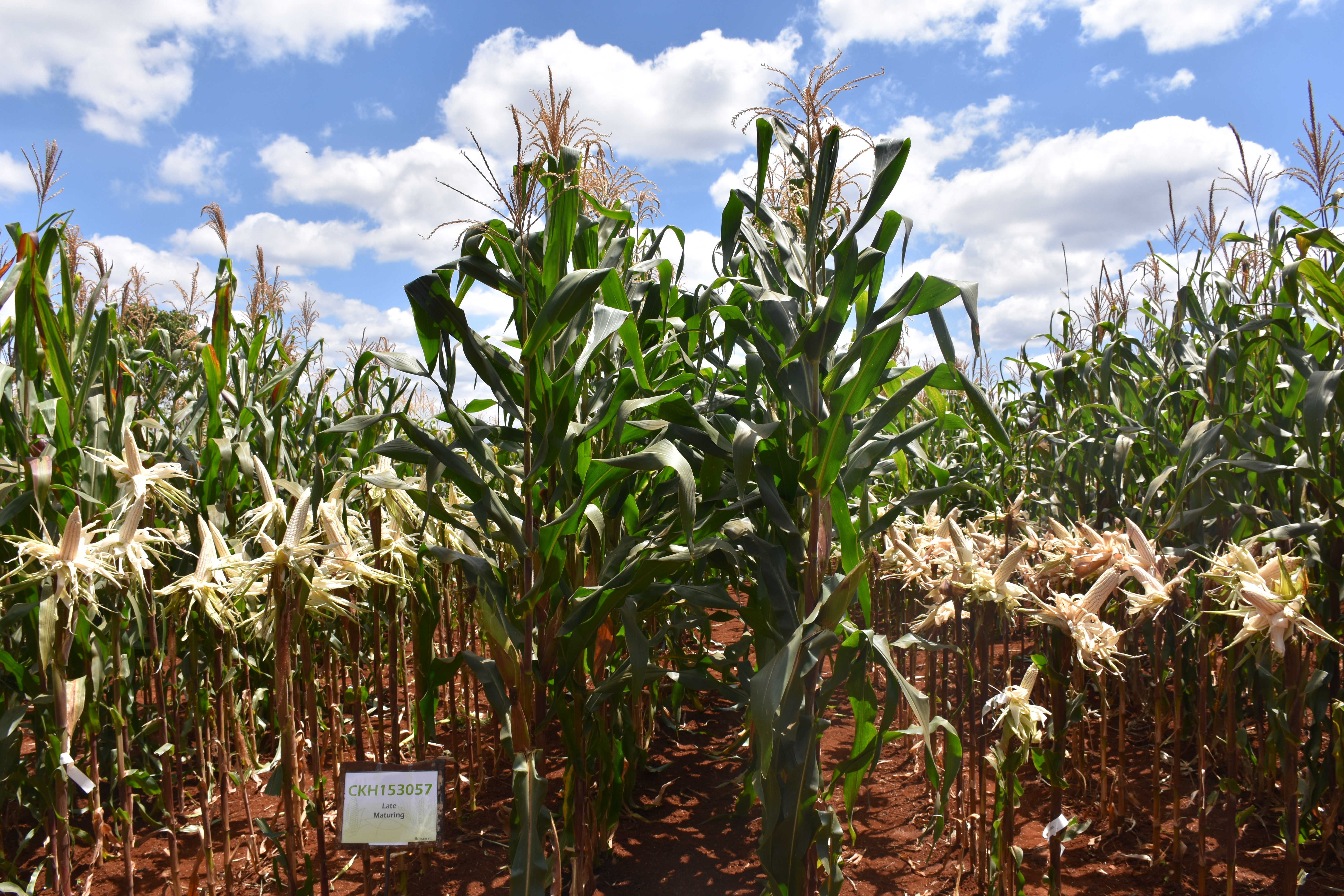
Innovations for a dynamic African seed sector
A vibrant local seed industry is needed for farmers to access improved varieties. Seed growers must be able to produce pure, high-quality seeds at competitive costs so they can flourish in business and reach many smallholder farmers.
Double haploid technology enables breeders to cut selection cycles from six to two, ultimately reducing costs by one third while ensuring a higher level of purity. Sixty percent of CIMMYT maize lines are now developed using double haploid technology, an approach also available to partners such as the Kenyan seed company Western Seeds.
The Seed Production Technology for Africa (SPTA) project, a collaboration between CIMMYT, KALRO, Corteva Agriscience and the Agricultural Research Council, is another innovation for seed companies enabling cheaper and higher quality maize hybrid production. Maize plants have both female and male pollen-producing flowers called tassels. To produce maize hybrids, breeders cross two distinct female and male parents. Seed growers usually break the tassels of female lines manually to avoid self-pollination. SPTA tested a male sterility gene in Kenya and South Africa, so that female parents did not produce pollen, avoiding a detasseling operation that damages the plant. It also saves labor and boosts seed yields. Initial trial data showed a 5 to 15% yield increase, improving the seed purity as well.
World-class research facilities to fight new and rapidly evolving diseases
The KALRO Naivasha research station has hosted the maize lethal necrosis (MLN) quarantine and screening facility since 2013. Implementing rigorous phytosanitary protocols in this confined site enables researchers to study the viral disease first observed in Africa 2011 in Bomet country, Kenya. Working with national research and plant health organizations across the region and the private sector, MLN has since been contained.
A bird’s eye view of the demonstration plots is the best testimony of the impact of MLN research. Green patches of MLN-resistant maize alternate with yellow, shrivelled plots. Commercial varieties are susceptible to the disease that can totally wipe out the crop, while new MLN-resistant hybrids yield five to six tons per hectare. Since the MLN outbreak in 2011, CIMMYT has released 19 MLN-tolerant hybrids with drought-tolerance and high-yielding traits as well.

A major challenge to achieving food security is to accelerate the varietal replacement on the market. CIMMYT scientists and partners have identified the lengthy and costly seed certification process as a major hurdle, especially in Kenya. The Principal Secretary of the State Department for Research in the Ministry of Agriculture, Livestock, and Fisheries, Hamadi Boga, pledged to take up this issue with the Kenya Plant and Health Inspectorate Service (KEPHIS).
“Such rapid impact is remarkable, but we cannot rest. We need more seed companies to pick up these new improved seeds, so that our research reaches the maximum number of smallholders,’’ concluded Prasanna.
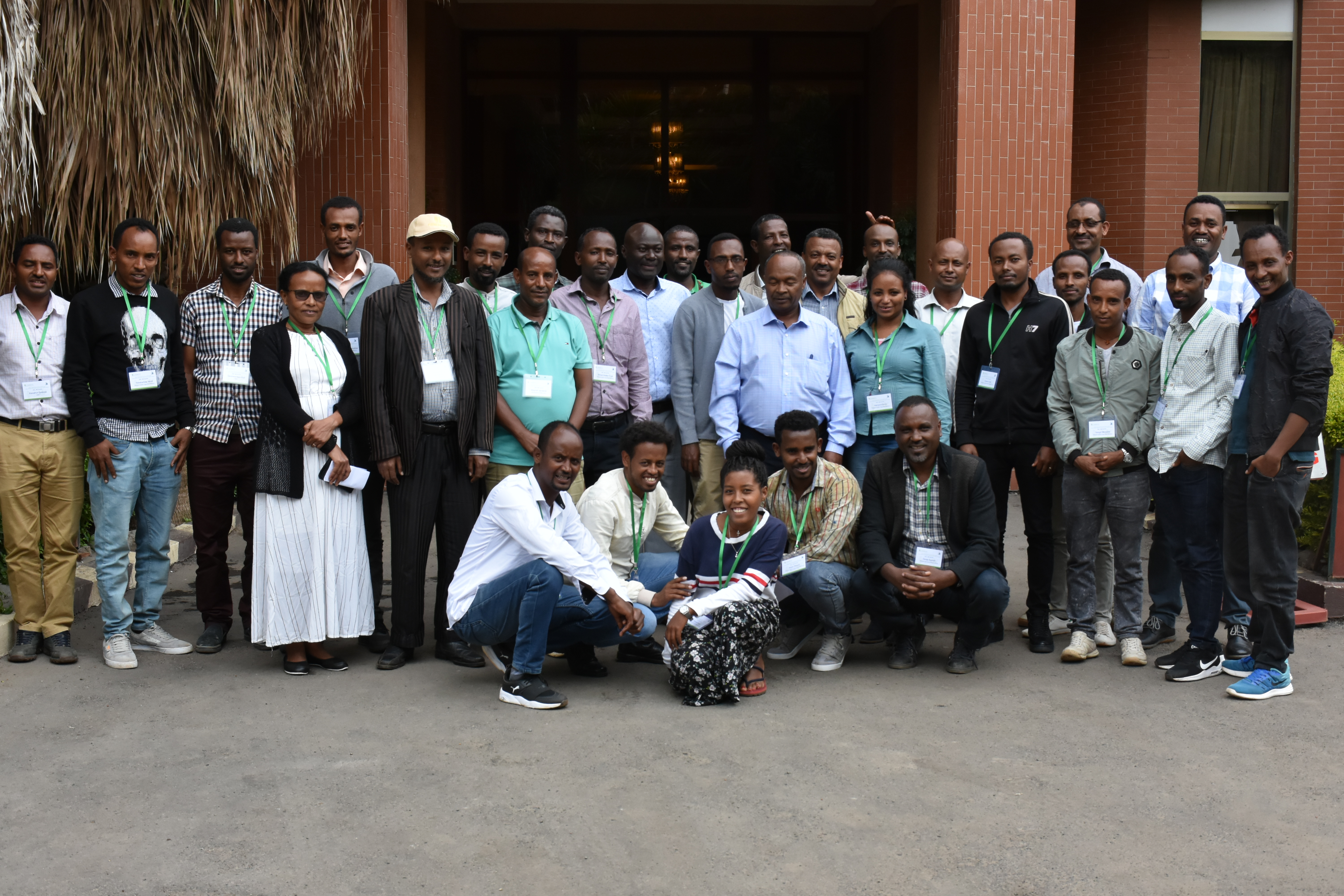
From July 22–26, the Stress Tolerant Maize for Africa (STMA) project organized a training in Adama, Ethiopia to update maize technicians on recent developments in maize research, data collection and seed production. The training was designed to stimulate good breeding programs, good data collection in trial and nurseries, production of better quality seed and development of improved varieties. Around 25 trainees attended, mainly from maize breeding research centers. Similar trainings were conducted in all STMA project countries over the last three and a half years.
CIMMYT staff from Ethiopia, Kenya and Zimbabwe and staff from the Ethiopian Institute of Agricultural Research (EIAR) Bako Research Center delivered training on methodologies and gave practical demonstrations on tablets. Presentations focused on the origin and botany of the maize plant, constraints to maize production in Ethiopia, data collection, breeding for abiotic stresses, new tools for phenotyping, maize lethal necrosis (MLN), and seed quality control.
Mandefro Nigussie, Director General of EIAR, said that the training was important because it addressed data collection. “If we are missing the data, we are missing the investment of the country,” he noted. He recognized CIMMYT’s culture in empowering research centers through trainings. The role of EIAR is to generate, test, disseminate and scale technologies. Therefore, having technicians who are aware of the recent developments in their areas is crucial.
Cosmos Magorokosho, maize breeder and STMA project leader, said that the core components of the training were to give technicians a strong understanding of the basics of maize and the physiology of maize plant. The knowledge they gained from this training will support them during data collection and when breeding for resistance to diseases and pests and improved seed production.
Upon completing five days training, all trainees received certificates along with the presentations and other relevant documents for future reference. CIMMYT maize breeder Dagne Wegary said he appreciated the active participation and dedication of the trainees and the interest they showed to improve their knowledge and skills. He reminded them that this is the start of a long journey and they will have to use the knowledge and skills gained to help farmers produce more and ensure food security. Trainees reflected that the training increased their existing knowledge in maize breeding and helped them to understand the current developments in the area. They said they would directly apply what they have learned and transfer the knowledge to other colleagues working in maize breeding.
This year opens the Decade of Family Farming (#FamilyFarmingDecade), which aims to improve the life of family farmers around the world. In an earnest discussion, two leaders in the global agriculture community reflect on the challenges facing family farmers, the promises of high- and low-tech solutions, and their hopes for the future.
A conversation between Martin Kropff, Director General of the International Maize and Wheat Improvement Centre (CIMMYT) and Trevor Nicholls, CEO of CABI.
Trevor Nicholls (CABI): Family farmers come in many shapes and sizes but for me, the words “family farmer” bring a focus on smallholders and people who are starting on a journey of making a farming business. It depends on which part of the world you’re talking about; a family farm in the UK is perhaps very different to a small family farm in Ethiopia. And family farms can grow from just a small plot to being quite large commercial enterprises.
Martin Kropff (CIMMYT): All agriculture started with family farms. Fifty years ago in my home country, the Netherlands, farms were almost all family farms. When we look globally, farms in places like India, Pakistan, and Kenya are very often small, and the whole family is involved.
KROPFF: When the whole family is involved, gender dynamics come out. In a way, family farming is very often the farming done by women. This makes women the most important players in agriculture in many developing countries. It’s crucial to recognize this and understand their decision-making. For example, our research shows that men and women value different traits in crop varieties. We need to understand this to have successful interventions.
NICHOLLS: We’ve seen something similar through our Plantwise plant clinics, where farmers come for practical plant health advice. We see a definite pattern of men bringing in cash crops for advice, and women looking more at fruits and vegetables to feed their family. But overall, mostly men come into our clinics, particularly in certain parts of the world. We’re trying to encourage more female participation by timing the clinics so that they fit into women’s routines without getting in the way of taking care of elderly relatives or getting kids off to school. Sometimes really simple things can open up access and improve the gender balance.
KROPFF: When the whole family is involved, there are also downsides. In Africa, young people do much of the weeding.
NICHOLLS: That’s right, they may be pulled out of school for weeding.
KROPFF: This really worries me. Hand weeding is such hard labor, such an intensive use of energy; it seems like it should be something of the past. Children don’t want to do it anymore. My wife is from the generation where children still did weeding in the Netherlands. She remembers standing in the fields weeding when the sun was extremely warm while her friends were out doing other things.
NICHOLLS: It starts kids off on the wrong path, doesn’t it? If their experience of farming is backbreaking weeding from the age of 8 onwards, it’s highly unlikely to attract them into farming as a career.
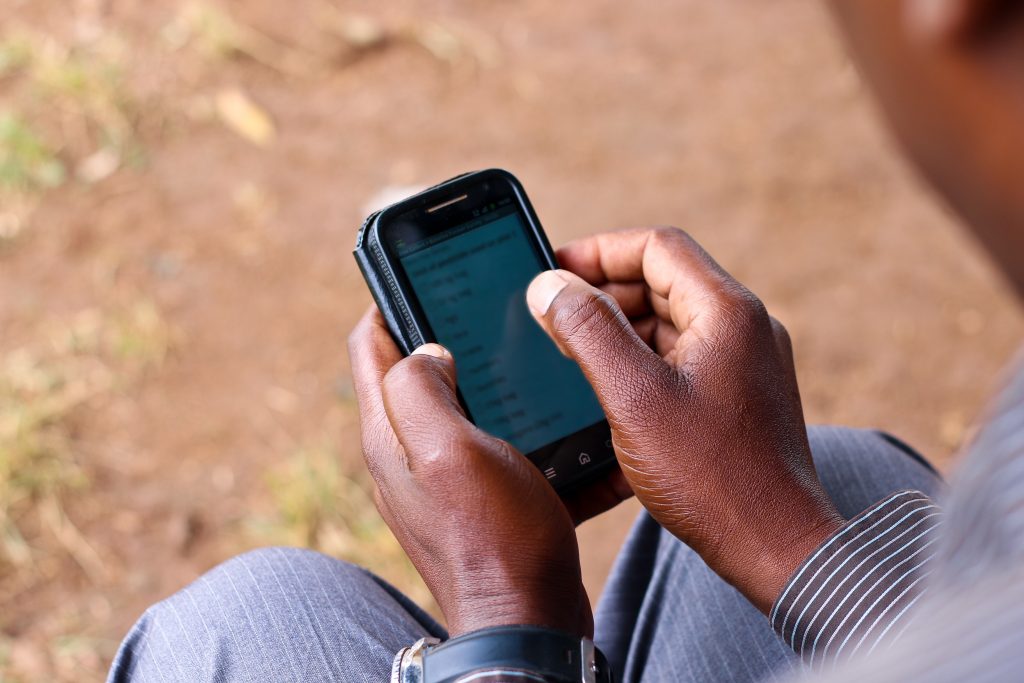
NICHOLLS: We need to look at things like weed control as a social issue. It’s possible, for example, to use beneficial insects to limit the spread of certain weeds that infest farmland. Biocontrol and Integrated Pest Management should be seen as ways of reducing the spread of certain weeds, and also as ways to reduce the burden on women and youth.
KROPFF: I agree. Similarly, we’re finding that small-scale mechanization is making a difference for youth, and also women’s labor in Latin America, Africa and Asia, where CIMMYT has been introducing two-wheel tractors that can be engineered in local workshops. Suddenly, smallholders can harvest the entire wheat crop of 20 families in one day. This saves so much time, money, and effort, eliminating some of the “bad” labor that may discourage youth and unfairly burden women. Farmers can focus on the “nice” aspects of the business. It’s a real game changer for family farming.
NICHOLLS: Yes and this can also be amplified through digital technology. People refer to the “Uber-ization” of tractors, where farmers are able to hire a piece of mechanical equipment for a very short space of time, and maybe it even comes with an experienced driver or operator. We’re finding that digital tools like artificial intelligence, satellite imaging, smartphones, and other modern technologies, will intrigue youth anywhere in the world. These will hopefully have an impact on bringing more youth back into farming, as they start to see it as technologically enabled rather than straightforward muscle power.
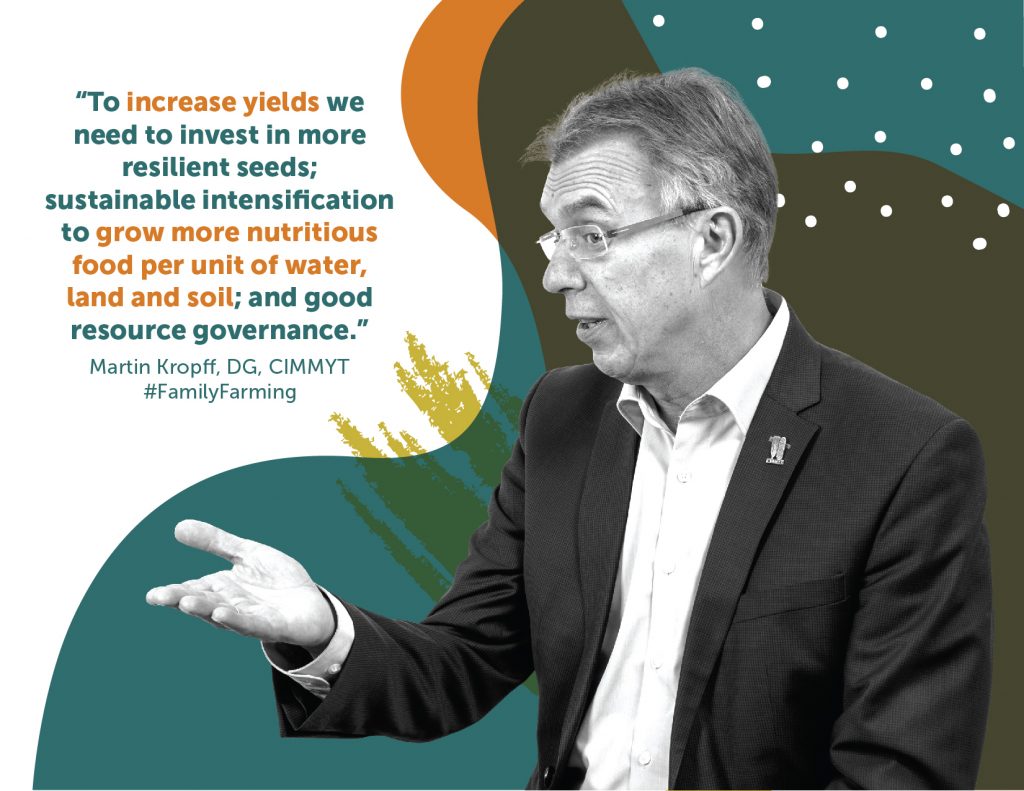 On the transformations that need to happen
On the transformations that need to happenKROPFF: If we want to keep youth engaged, and improve farmers’ livelihoods, I think farming needs to become more entrepreneurial. Many family farms are only half a hectare. I think this has to grow somehow, though land rights and ownership are a challenge
NICHOLLS: As farming becomes more business-like in Africa then we’re going to see the same sort of consolidation that we saw in the United States and Europe, whereby farm sizes do get larger even if land ownership remains fragmented.
This could happen through cooperatives, which offer economies of scale and also help farmers spread the costs of things like access to inputs, advice, weather insurance and crop insurance. But we need to view cooperatives as more than a way to infuse new technologies into the farming system. They are in fact a channel for helping farmers gain stronger business skills, so they can get a better bargain for themselves.
KROPFF: In Mexico we are working with 300,000 smallholder farmers in a sustainable maize and wheat sourcing initiative. Rather than “pushing” new varieties and technologies at farmers, we help them partner with maize and wheat companies to create a local demand for high quality, sustainable products. Real scaling up, especially for wheat and maize, needs more than extension. Farmers need better links to the market.
NICHOLLS: If farms get larger and more mechanized, it means fewer people are involved in the business of farming. This shift means that people will need other rural occupations, so that they don’t just leave the land and move to the city. We need investments in other productive activities in rural areas. This could be around post-harvest processing of crops: adding value locally rather than shipping the raw materials elsewhere.
KROPFF: Exactly. We’ve been doing more work on this in the last ten years. CIMMYT works on wheat and maize, and these are products that need to be processed. Doing this locally would also help people save food in the future for more difficult times, instead of selling to someone from the city who may buy it for an unfair price. Farmers these days have access via smartphones to market information, which is empowering. We see it happening in Africa. It’s really crucial.
NICHOLLS: We’re certainly seeing the power of digital technologies, which are also helping us move beyond just responding to crop pests and diseases to being able to get better at predicting outbreaks on a micro-scale. By linking ground observations through our Plantwise clinics with satellite observation technology and data, we’ve developed a program called PRISE (Pest Risk Information SErvice), which provides farmers with alerts before a pest is likely to reach its peak point, so that they can be prepared and take preventative measures.
KROPFF: Without a doubt, smallholder farmer communities are rapidly entering the digital age, and tools on weather prediction, selection of varieties, market information are very important and transforming the way people farm.

KROPFF: Climate change is going to be the issue affecting family farmers, especially in Asia and Africa where the population will grow by 2 billion people who need food that has been produced on their own continents. Yields have to rise and climate change brings yields down. We have to help smallholder family farmers keep doing their job and ensure crop yields, which is why climate change is embedded into 70% of our work at CIMMYT. One major area is developing and testing heat- and drought-tolerant varieties that suit local climates. Last year I was in Zimbabwe, which was experiencing El Niño, and I was very impressed by the difference in maize yields from drought and heat-tolerant varieties compared to the normal varieties.
NICHOLLS: That’s very good. In addition to drought and heat, we see pests and diseases appearing in new places as a result of climate change. Pests and diseases will cause crop losses of up to 40% on average. Stemming those losses is critical. We’re seeing invasive species, such as fall armyworm, and many invasive weeds and trees that are effectively stealing arable and pastoral land from farmers, as well as water resources.
Pest-resistant crops have great long-term potential, but farmers also need short-term solutions while they wait for new varieties to become available. One of CABI’s strengths is scanning for solutions from other parts of the world. With fall armyworm, we are looking to South America, where the pest originates, for solutions and natural enemies. We’re also scanning our fungal culture collection for samples that may have properties that can form the basis for biopesticides, and therefore open up a program of biological control.
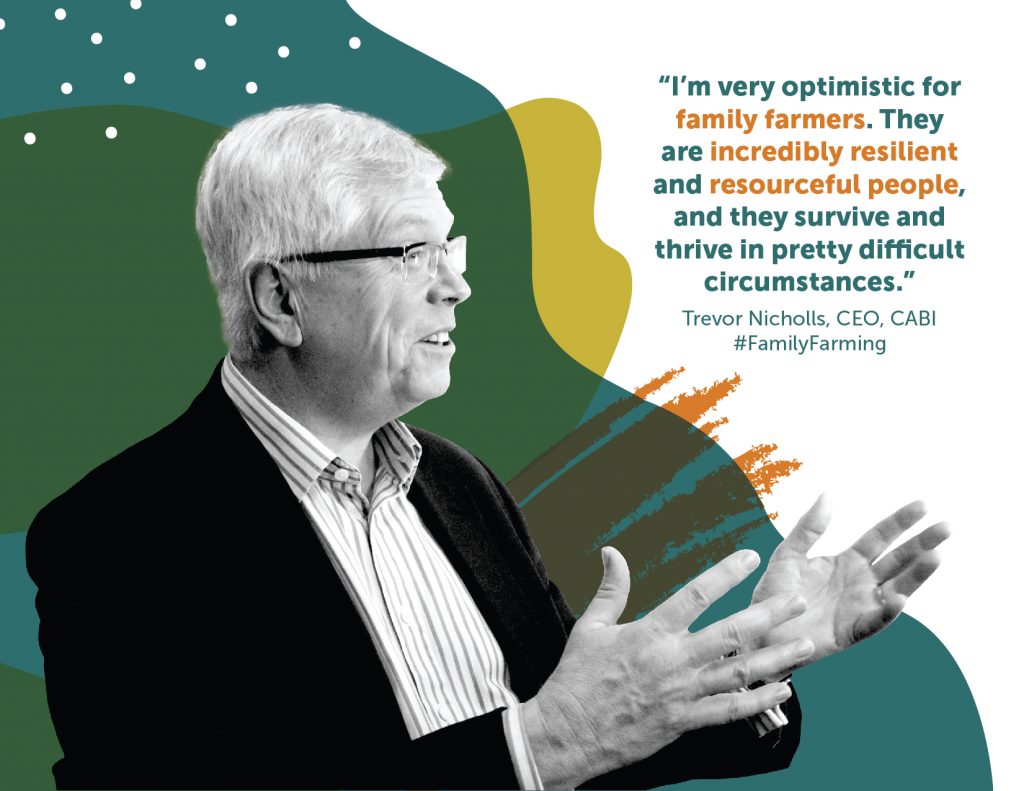
NICHOLLS: I’m very optimistic for family farmers. They are incredibly resilient and resourceful people, and they survive and thrive in pretty difficult circumstances. But the world is getting more challenging for them by the day. I think the Sustainable Development Goals (SDGs) have framed many of the issues very well, in terms of food security and livelihoods, sustainable consumption and production, and this will help to focus attention on family farmers.
I do see some quite encouraging signs, particularly in Africa, where the CAADP (Comprehensive Africa Agricultural Development Programme) has brought much greater coordination among countries. We’re seeing more unity in the requests we receive from our member countries to help them address the issues that are in the SDGs. That makes the work of our organizations easier, because we’re addressing a broader set of demands. And in turn, that will benefit family farmers.
Technology, be it biotechnology or telecommunications and ICTs, is becoming so much more affordable over time. The rate that smartphone usage is spreading in Africa and Asia is incredible. In many areas we actually have most of the technology we need today. It’s about getting it put into practice effectively with large numbers of farmers. So I remain very optimistic about the future.
KROPFF: I’m an optimist by nature. That’s also why I’m in this job: it’s not easy, but I really believe that change is possible if we have our act together and collaborate with CABI and other international research partners, national systems and the private sector. For a long time, people said that there was no Green Revolution in Africa, where yields remained one ton per hectare. But today we see yields increasing in countries like Nigeria, and in Ethiopia, where maize yields are 3.5 tons per hectare. Good things are happening because of family farming.
I believe that to increase yields you need three components: better seeds for more resilient crop varieties; sustainable intensification to grow more nutritious food per unit of water, land and soil; and good governance, to properly manage resources. We need to invest in all of these areas.
NICHOLLS: I fully agree. We need to work on all these areas, and harness the power of modern technology to help family farmers thrive now, and in the future.
This interview has been edited for length and clarity.
Learn more about key actions needed to support family farmers: CIMMYT and family farming
Join the conversation at #FamilyFarmingDecade.
This year’s African Green Revolution Forum (AGRF), which took place from September 3-6, 2019 in Accra, Ghana, focused on the potential of digital agriculture to transform African agriculture through innovations such as precision agriculture solutions for smallholder farmers, access to mobile financial services, data-driven agriculture, and ICT-enabled extension.
Committed to a digital transformation of African agricultural that benefits many, not a few.
The CGIAR has become a new partner of the AGRF and was presenting during the forum its five global challenges: planetary boundaries, sustaining food availability, promoting equality of opportunity, securing public health, and creating jobs and growth.
Despite its importance of the continental economy and untapped resources, African farming sector is still dominated by ageing smallholders cultivating few acres of cropland, using not much inputs and lagging far behind productivity world standards.
Many experts believe digital agriculture could help African agriculture leapfrog to overcome its geographical, social and economic bottlenecks, bringing successful technologies to scale faster, and market opportunities even for remote smallholders. Some countries like Ghana or Kenya are becoming digital hubs for agritech-savvy young entrepreneurs along the food value chains, from drone for Ag, linking farmers to the marketplace, or offering mobile mechanization or financial services.
Large initiatives were announced to foster this growth potential, in particular towards the youth in agriculture, like the Mastercard Foundation’s commitment to invest $500 million to support for young agripreneurs within its Young Africa Works initiative, and the World Bank’s One Million Farmer platform in Kenya.
In force at the AGRF 2019, agricultural research organizations such as the International Maize and Wheat Improvement Center (CIMMYT) have a strong role to play in this digital transformation, both as innovator creating for instance new digital maize phenotyping tool for faster yield assessment, and user of tech innovations to improve research targeting and impact.
Improving smallholders’ resilience through digital innovations
The millions of African rainfed farmers are in a risky business, from rising climate shocks to emerging pests and diseases like the invasive fall armyworm or the maize lethal necrosis. CIMMYT Director General Martin Kropff highlighted the importance of digital tools to predict these risks through smart, scalable early warning systems like the award-winning diagnostic tool Marple that helps map wheat rust outbreaks. Researchers can also better predict the farms’ responses to these risks through accurate modelling. They can for instance better assess the potential yield benefits of drought and heat tolerance under different climate change scenarios.
CIMMYT crop breeders use tablet-based disease scoring applications and test new imagery and high-tech sensors for more accurate and cost-effective data collection. Kropff underlined the key role digital tools play to speed up science breakthroughs and impact delivery at the farm level.
Tailored advice for farmers and policy-makers to enable sustainable intensification
“The future is no longer where it used to be. Farmers’ reality has become even more unpredictable,” said Enock Chikava, deputy director, agricultural development at the Bill & Melinda Gates foundation during a vivid debate on how to reshape the future agronomic research so it delivers more site-specific and responsive advice.
Much of the agronomy work within the region remains fragmented across research institutes, commodities and projects, and struggles to go beyond blanket recommendations that are most of the time not adapted to local farming conditions.
However, there is a fast-growing wealth of georeferenced data that can describe the diverse farming landscapes and socio-economic context of each African smallholder farmer. The starting point to exploit these data and get the right solutions for each farmer is to ask the right questions.
Moderated by Samuel Gameda, CIMMYT soil scientist, who shared the lessons from the Taking Maize Agronomy to Scale (TAMASA) project, this session on Agronomy at Scale discussed what public information goods like crop yield prediction maps or extension apps, such as the maize variety selector, would be the most useful for farmers and large-scale agronomic initiatives to trigger this much needed sustainable intensification of millions of African smallholdings. What investments would make a difference to scale the use of these new decision-support tools?
“Agronomic research must be carried out from a broader perspective of large-scale relevance and application. It is also more and more a joint effort and responsibility between smallholder farmers, the research community and public and private sectors, with each component playing specific and interacting roles. The current era of powerful and accessible ICT tools and big data analytics make this much more feasible and should be incorporated to enable precision agronomy for all, this is my take home message,” said Gameda.
“This data revolution will only work if we invest in research data quality and data management,” stressed Bram Govaerts, CIMMYT’s Integrated Development Program director. “That will generate better evidence for decision-makers to guide impact investment plans, deciding on which technology e.g. a new drought-tolerant crop variety and put the money in the right leveraging point,” Govaerts concluded.
The largest forum on African agriculture, AGRF 2019 gathered more than 2,200 delegates and high-level dignitaries, from heads of State and government officials to leaders of global and regional development institutions; top agri-food businesses and local entrepreneurs; financial institutions; mobile network operators and tech leaders, as well as lead representatives of farmer organizations.
Cover photo: Delegation from the International Maize and Wheat Improvement Center (CIMMYT) at the African Green Revolution Forum (AGRF) 2019.